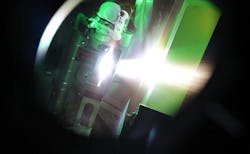Los Alamos, NM--Researchers at Los Alamos National Laboratory (LANL) have successfully demonstrated for the first time that laser-generated neutrons can be enlisted as a useful tool in the War on Terror. The international research team used the short-pulse laser at Los Alamos's TRIDENT facility to generate a neutron beam with novel characteristics that interrogated a closed container to confirm the presence and quantity of nuclear material inside. The successful experiment paves the way for creation of a table-top-sized or truck-mounted neutron generator that could be installed at strategic locations worldwide to thwart smugglers trafficking in nuclear materials.
"We have demonstrated for the first time a novel approach for generating a record number of neutrons driven by a laser directed into a beam over a very small area that could provide proof positive of a large variety of nuclear items," said Los Alamos physicist Andrea Favalli, an Italian researcher who led the experiment.
For the experiment, researchers at Los Alamos's TRIDENT facility focused an extremely short and intense laser pulse onto an ultra-thin foil of deuterated plastic—a material in which hydrogen atoms within the foil were replaced with deuterium isotopes. To put the extraordinary experimental parameters in perspective, the power of the TRIDENT pulse is 50 times greater than the entire production of worldwide electrical power packed into a burst of energy lasting only one-half of one-thousandth of a billionth of a second (0.5 picoseconds). The TRIDENT beam is focused at the target into a spot 12 times smaller than a human hair. The thickness of the laser-target foil (0.3 microns) is about 300 times thinner than a human hair.
When this tremendous laser burst hits the foil target, it transfers much of its energy into the deuterium nuclei—the hydrogen isotope with one proton and one neutron—accelerating those particles into a beam traveling at about one-tenth of the speed of light into a second metal target located five millimeters beyond the foil. When the fast-moving deuterons slam into the secondary target, they create a blizzard of very fast moving neutrons (up to 40 billion of them, moving at a fraction of the speed of light) in a directed bunch lasting a billionth of a second, in a cone with an angle of about 30 degrees.
In fact, the TRIDENT laser is so good at producing neutrons that it has shattered the previous world record number of neutrons in a laser-generated beam, and drove those neutrons to an energy of more than 150 million electron volts (150 MeV), or more than ten times the energy of neutrons from D-T fusion as produced in devices such as the National Ignition Facility at Lawrence Livermore National Laboratory.
In the current experiments, the research team demonstrated that these laser-produced neutrons can be used to search for hidden nuclear material. Neutrons are a good choice as a probe because they can penetrate most materials very easily. If the neutrons encounter some nuclear material (like uranium or plutonium) they cause fission and more neutrons are released. Some of these released neutrons are produced over a period of seconds, which allows them to be measured after the initial neutron burst is finished. These 'delayed neutrons' are a good measure of the presence of nuclear material because very few other materials produce them.
The scientists interrogated a closed container with nuclear material inside and an empty closed container and then compared the results. They found that the laser-driven-neutron-interrogation method not only confirmed the presence of nuclear material, but it told them the quantity as well.
"This is something that has never been demonstrated before," Favalli said. "Up until this experiment, nuclear material detection with a single laser-generated neutron pulse was merely an idea. Our team invented the concept, fabricated all the materials necessary for the experiment, and confirmed our results within three weeks from start to finish. This is a little bit like the original days at Los Alamos National Laboratory. It is very exciting!"
Detecting and interdicting clandestine nuclear material using active interrogation has been somewhat impractical up until now because doing so would require a giant, stationary facility or long measurement times with less powerful neutron generators. The TRIDENT experiment shows promise for the development of a small, portable neutron interrogator that could be used at border crossings or elsewhere. Neutron interrogation can also be used in other applications such as materials science or the biological sciences, and the use of lasers could make the technique practical in other laboratories and universities.
Los Alamos National Laboratory is patenting the process. More information can be found on LANL;s YouTube channel at http://www.youtube.com/watch?v=Cr1UKZ_e9Ik.
SOURCE: LANL; http://www.lanl.gov

